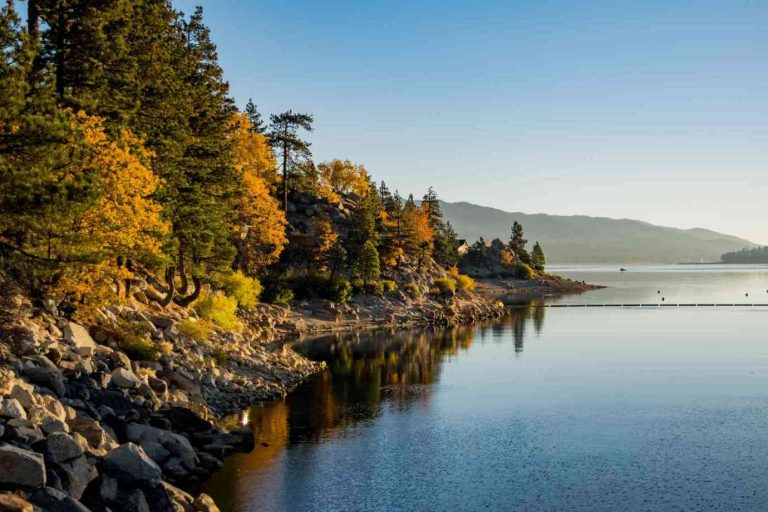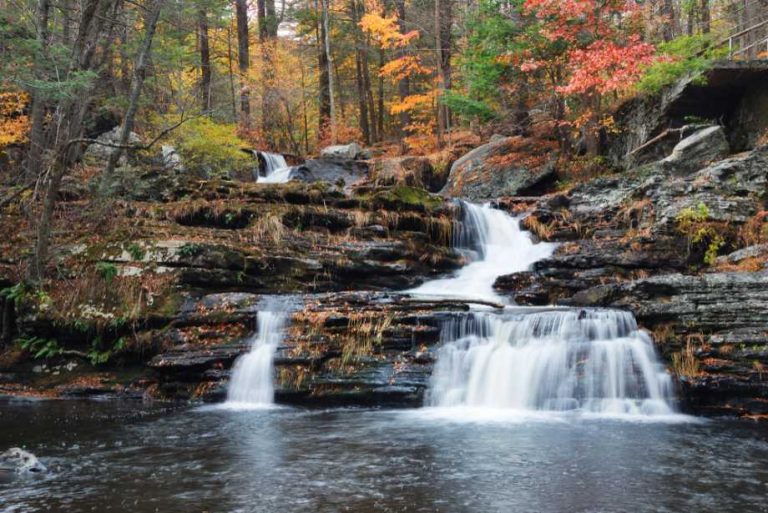I’ll never forget the first time I paddleboarded across Big Bear Lake. It was a calm, early summer morning—just me, the mountain breeze, and the glassy water. Somewhere around the center of the lake, I paused and looked down. The water turned from clear to deep, inky blue. Naturally, I had to Google it the moment I got back to shore—Big Bear Lake depth map and all: how deep is Big Bear Lake?
Turns out, there’s more happening beneath the surface than I ever imagined.
What’s the Real Depth of Big Bear Lake?
Big Bear Lake reaches a maximum depth of 72 feet (22 meters). On average, the lake is about 35 feet deep (11 meters). That means much of the lake is shallow enough for casual recreation, while certain areas plunge into deeper waters perfect for boating and fishing.
Whether you’re paddling near the edges or heading to the middle for a deep dive into nature, knowing the lake’s depth adds a new layer to the experience.
Is it a natural lake?
Nope! Big Bear Lake is a man-made reservoir, first created in 1884 and expanded in 1912. It sits in the San Bernardino Mountains and is replenished by snowmelt and rainfall.
Because of its reservoir status, the lake’s water level—and therefore its depth—can fluctuate based on seasonal weather and water usage. After heavy snowfall, it’s usually deeper and fuller. During drought years, the shoreline may recede noticeably.
How does the depth affect lake activities?

Depth plays a big role in what kind of activities you’ll enjoy here. The shallower coves, like Boulder Bay or Metcalf Bay, are ideal for swimming, kayaking, and paddleboarding. These areas warm up faster in summer and are generally safer for families and beginners.
The deeper middle zones are great for fishing, power boating, or jet skiing. These areas stay cooler and attract more fish like rainbow trout and largemouth bass.
Does the depth change throughout the year?
Yes, and that’s part of what makes Big Bear Lake so dynamic. It naturally fluctuates based on rainfall and snowpack. Late spring and early summer usually bring higher water levels from melting snow. By late summer or during dry seasons, the depth may decrease.
This changing depth influences boat launch availability and fishing patterns, so locals like me keep an eye on it year-round.
How Lake Depth Affects Your Experience
Are there designated areas for deep or shallow water?
There are no strict zones, but experienced visitors know the layout. Shallow areas are typically near the shorelines and western bays. Deeper regions sit closer to the lake’s center and toward the dam on the eastern side.
Local rental shops and marinas can guide you based on what you plan to do—fishing, floating, or zipping around on a jet ski.
Is it safe to swim in the deeper parts?
Yes, but always use common sense. The lake is well-monitored with clear buoy markers and patrols. Still, I always recommend wearing a life jacket if you’re venturing into deeper sections—especially if you’re not a confident swimmer or are out alone.
Temperature differences can be pretty noticeable. Shallow water warms up, but deep sections stay chilly even in July.
How the Lake’s Depth Shapes the Local Ecosystem
What types of fish live in Big Bear Lake?
The variation in depth creates a great home for several species. Shallower, warmer water attracts sunfish and bluegill, while deeper, cooler areas are perfect for trout, catfish, and bass.
If you’re fishing from a boat or pier, knowing how deep the water is will help you target the right species. Depth charts are often available at tackle shops or rental kiosks around the lake.
Does the lake support year-round wildlife?
Absolutely. The mix of depths and temperatures attracts all kinds of wildlife—migratory birds, turtles, ducks, and even the occasional bald eagle. It’s a rich and diverse ecosystem that thrives because of the lake’s structure.
How to Explore Big Bear Lake by Depth

Planning your activities around the lake’s depth helps you get the most out of your visit. Here’s how I recommend organizing your day:
- Morning paddle in the shallow western coves where the sun hits early and water warms up fast.
- Midday boating or jet skiing in the deeper central section—especially if you’re looking for a thrill.
- Afternoon fishing in cooler, deeper waters on the east side, particularly if you’re after trout.
- Evening strolls along the shoreline trails to spot wildlife as temperatures drop.
By understanding where the lake is deepest and shallowest, you can match the activity to the area and enjoy everything Big Bear has to offer.
FAQ: Big Bear Lake Depth Questions, Answered
How deep is Big Bear Lake on average?
Big Bear Lake average depth is about 35 feet, with its deepest point around 72 feet near the dam. While it’s not the deepest lake in California, its depth still supports boating, fishing, and plenty of summer fun.
Can you swim in Big Bear Lake?
Yes! Swimming is allowed at Big Bear Lake swimming spots, though the water stays cool—even in summer. There are no lifeguards on duty, so swim at your own risk. Most people enjoy wading near the shoreline or taking a refreshing dip off a dock or kayak.
Is Big Bear Lake man-made or natural?
Big Bear Lake is man-made, originally built as a reservoir in the 1880s. It was expanded in the early 20th century to increase water capacity. Today, it’s a popular recreation lake surrounded by natural beauty and forest.
Why does Big Bear Lake water level change?
Water levels in Big Bear Lake fluctuate due to snowmelt, rainfall, and drought conditions. Since there’s no major river feeding into it, dry winters can lower the lake noticeably, while wet years bring it back up. Local water management also plays a role.
Beneath the Blue: Why Depth Adds to the Magic
Knowing how deep Big Bear Lake is adds a whole new layer to your experience here. Whether you’re lounging on a pontoon boat, fishing with friends, or just dipping your toes into the water, understanding what lies below makes it feel even more special.
This lake isn’t just a scenic escape—it’s a living, breathing reservoir with depth, character, and a rhythm of its own. And now that you know what’s under the surface, I hope you get out there and enjoy every inch—shallow or deep.















